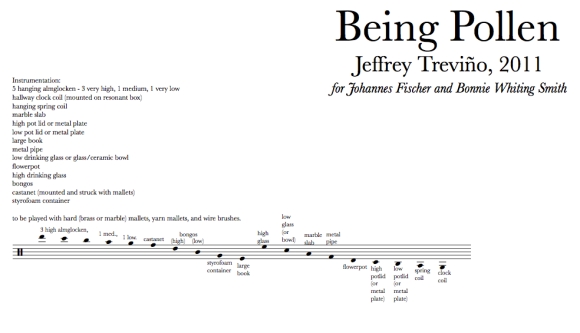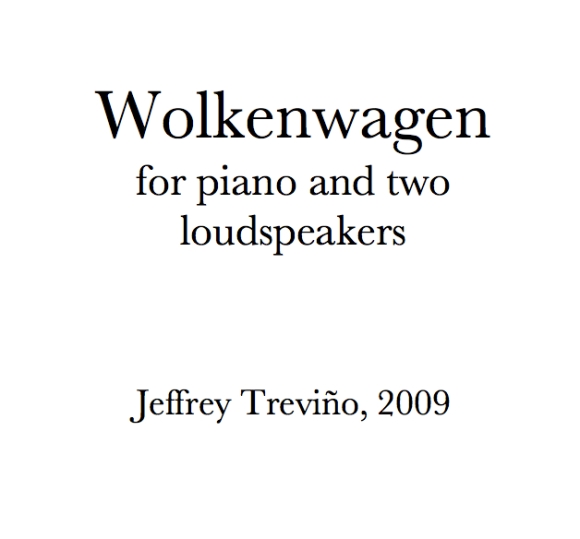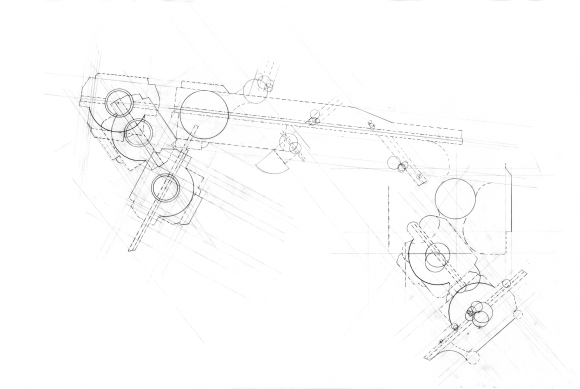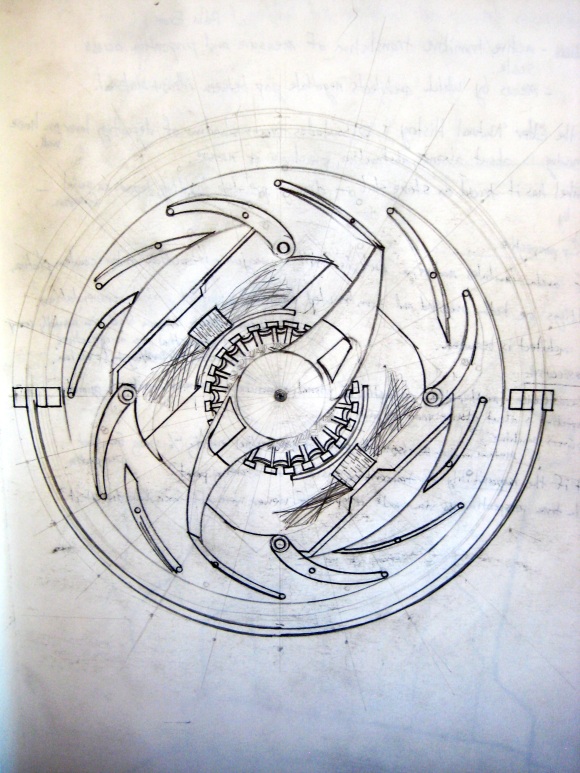“When you’re making something, and you don’t know what to do, make the move you can make. It’s like starting a jigsaw puzzle: find the corners first and go from there.”
This week MD offers you an exclusive interview with composer, pianist, tubist, scholar, architecture student, and winner of MD’s Hand Illustration Contest, Jeffrey Treviño. Whew! Talk about a masterdabbler. I’ve picked his brain about his research on composers and coding, iterative music, his current work, the relationship between visual art and notation–plus learn where to find free sounds and online programs to help you start generating your own music.
How long have you been composing? How did you start?
I arranged tunes for my ska band, Rigby Reardon and the Detectives, when I was in high school in Bakersfield. And then I wrote a piece for three electric toothbrushes when I was a freshman in college. You know that awesome filtering sound, when you open and close your mouth?
How would you describe your music?
Well, probably as uncompromising art music, since it doesn’t really fit into a genre. Or artifacts that result from a dialogue with technology, many of which happen to result in sound.
You’ve done some really cool research at UCSD regarding the way composers think when writing computer programs. How did you stumble upon this topic?
I started studying this because I didn’t enjoy composing in the traditional way. This will sound like heresy, and I know so many people truly enjoy it, but — I hated that working with paper, drawing dot after dot, meant that a single iteration of the work would take such a long time to make. So I wanted to work in a radically iterative way, where I could think of constraints that would govern the whole work and then gradually add detail to many completed or quasi-completed versions of the notation.
I started thinking of computer programming as a kind of instruction-based art that could participate in the tradition of Fluxus. There’s a lot of computer-based music that draws on traditions from popular science — cellular automata and chaos theory stuff that got published in Scientific American — but there is also a minor literature of computer-aided composing that links to the American experimentalist tradition. Douglas Kahn and Hannah B. Higgins just edited this great book called Mainframe Experimentalism about early computational experimental work, in all the different areas of art.
So, iterative music follows a repetitive sequence of constraints?
Well, it’s important to recognize that it’s possible to be working in this iterative way — generating a pdf of a formatted score, changing the code, generating the score again, changing the code, over and over — without making music itself that seems to be based on repetition at all. The process of composing is repetitive and refining, but the music might be very different from the nature of the process that composes it.
Is iterative composing common?
I’m in touch with four or five other people who work the same way, but there are probably more. I hope this kind of thing becomes more common among composers, or even among artists who are interested in using computation to make things. NewMusicBox published an interesting article about some new ways that composers are approaching notation, including Abjad work by Baça, Oberholtzer, and myself. I guess it won’t be possible for people to think about seriously doing things this way unless we start teaching people in music programs how to write code, though.
What did you learn about the way composers think when writing code?
I don’t study that anymore. It turns out that composers still think creatively when they write programs. All done! It was interesting to see many different programs that reflected the metaphors of many different creative practices, but that was not such a surprising research finding.
What do you research now?
I reoriented my research toward the documentation of my own novel use of technology. My advisor, the composer Rand Steiger, turned me on to these composers at Harvard, Trevor Baça and Josiah Oberholtzer, who have been working on this Python library for making musical scores with this open-source typesetting engine called LilyPond. I contributed some source code to their system for iteratively generating music scores by writing computer programs — www.projectabjad.org — and just used it to write a trio called The World All Around for Wild Rumpus New Music Collective in San Francisco, which will premiere on May 11th, at Salle Pianos on Market Street. It takes about seven seconds to make a new draft of the seventeen-page score, which is based on a small set of simple rules, inspired by the works of Marcel Duchamp, John Cage, and Maurice Sendak. It was about two years of solid work, and it felt like starting from scratch with something I’d done for almost ten years, but it’s satisfying to work in such an iterative way — I generated about 800 .pdf files on the way to the ten drafts of the finished score that I just sent the group.
What is the set of simple rules The World All Around is based on?
There are rules that create these weird connections between the parts. So, like, the harp part is built of notes as long as all the distances between rests in the clarinet part. And there are these arbitrary correspondences between things that I like, because they end up giving this uncanny unity to things. Other things are pragmatic, like, don’t write a note that’s too high or low to play! Everything in the whole composition is modeled as a constraint, including the duration of the whole piece. So the group read it, and I decided it was twice as long as it should have been, and I was able to change a number in the program and rescale the whole thing. Which notes and intervals (relationship between notes) occur in different sections of the piece were modeled.
But I shouldn’t make this sound all command-and-control-ish. Many of the rules are implemented using shuffling techniques or constrained randomness, such that a different seed value for the random number generator produces a totally different score every time. The work comes very much out of John Cage and Marcel Duchamp, who were more interested in measuring things than imagining what an experience would be like. The experience is an artifact, a side-effect of designing ways to measure things.
What inspires your compositions?
I’ll start out with literary inspiration often since a reference to a shared story can be a good way to invite people into the same fictional space you’re in. For example, because Wild Rumpus took their name from Where the Wild Things Are, and because Maurice Sendak just passed away, I based the trio for them on a passage from the book, where Max sails home for a year from the land of the wild things. So even though I use computers to compose, my aesthetics are right out of the first half of the 19th century; the idea of programme music (i.e. like Hector Berlioz, who tells the story about a composer who does opium and kills the object of his unrequited love in his symphony entitled Fantastic Symphony: An Episode in the Life of an Artist, in Five Parts or Robert Schumann, who considered himself equally a poet and composer, and wrote an essay about how writing poetry and composing are fundamentally the same thing) is really important to me.
But sometimes there’s even a stronger link to the literary inspiration. I recently started a project based on the description of a concert in Helen DeWitt’s novel, The Last Samurai, and I also did a solo percussion piece called Being Pollen with the poet Alice Notley, which includes recordings of her reading her poems.
Bonnie Whiting-Smith performing Jeffrey Treviño’s Being Pollen, 2011.
Performance instructions and composition of Being Pollen. Courtesy of Jeffrey Treviño.
I enjoy the found sounds/recordings you include in your work.
There’s this amazing site called freesound.org, where people just post sounds they like and invite people to use them however they want. So the recordings of film projectors in Wolkenwagen (Cloud Wagon) for piano and electronics, for example, are taken from there. I like to use recordings that evoke feelings of nostalgia, I think. I don’t remember the movies we watched in elementary school, but I remember the noises the projector would make before the movies would start.
Performance instructions and composition of Wolkenwagen. Courtesy of Jeffrey Treviño.
Can you tell us more about your winning image?
It’s a drafting sketch that was done in 45 minutes in an architecture studio at UC Berkeley last summer; they have this awesome summer program called IN[ARCH] for people who want to learn some architecture skills. I was playing with construction lines in architectural drafting, which I had learned about that morning, where you have these super faint lines that act just as guides for the placement of the other lines. So I would alternate between repeating a stencil with dark lines and drawing out more skeleton lines to follow with the darker stencil lines. The stencil was an abstraction of a drawing of a vacuum cleaner motor that I made. The dimensions of the stencil change and stretch. A side that was straight might suddenly turn into a curve. The circles in the middle of the stencil might take on a life of their own and start decorating things. But it’s mainly the successive negation of a single object. The different kinds of lines finally corresponded to different kinds of folds and cuts, which let the whole drawing sort of pop up into a terrain, which was the assignment in the studio.
Jeffrey Treviño. Sketch for vacuum cleaner terrain, 2012, graphite on vellum, 24″ x 36″.
How does drawing relate to music?
Well, a composer is a graphic artist. Composers make a graphic artifact, a notation, that happens to be handed off to someone else for sonic response in many cases.
There’s a lot of talk about material and development in composition. So you can think of an object of some kind, and you proceed by proposing new objects, or by repeating some object — but the objects don’t stay the same, either because, as Brian Eno says, repetition is a form of change, or because the composer has tweaked the repeated object. Transposition, where you repeat a motive starting on a different pitch, is a great example of negating something about an object. You repeat the object, but something about its identity has been both preserved and revised, with enough preserved to maintain the core identity of the object. Or not — in which case negation results in proposition! Whoa.
Jeffrey Treviño. Sketch of vacuum cleaner, 2012, graphite and pen on vellum.
What’s your advice to other creatives?
When you’re making something, and you don’t know what to do, make the move you can make. This is the way that Mark Applebaum taught me to think about composing. It’s like starting a jigsaw puzzle: find the corners first and go from there. There’s probably some enabling constraint lying around that will inspire you to make the next choice in a way you weren’t considering before. The whole idea that creativity works by sitting around and waiting for some quasi-divine, epiphanic inspiration is beautiful, but not especially helpful. Think about what’s there, in front of you, and notice new things about it, and what it needs from you, what it proposes.
What’s next for you?
I’m really excited about computation in the arts more broadly, and I’m going to continue my work by studying architecture at MIT starting in September.
To learn more about Jeffrey Treviño and his work, visit www.jeffreytrevino.com. He is currently a doctoral candidate in music composition at University of California, San Diego. His work has premiered at such notable institutions as New York City’s Symphony Space, South Korea’s Seoul International Computer Music Festival, Germany’s Akademie Schloss Solitude Summer Residencies, and the International Conference of the Society for Improvised Music. He has also performed in world class venues such as Carnegie Hall, the Sydney Opera House, and the Walt Disney Concert Hall in Los Angeles. For more information about the premiere of his new trio The World All Around on May 11th for Wild Rumpus New Music Collective in San Francisco, go here. Congratulations to Jeff for his acceptance to MIT beginning in September!






